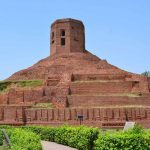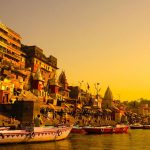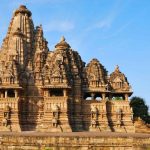The historic city of Bhuj derives its name from the Bhujiyo Dungar, a hill, overlooking the present day Bhuj town. Bhuj is a typical example of a desert town located between two geographical features – Bhujiyo Dungar on the east & Hamirsar Lake on the west. Bhuj, the major town of Kutch, is an old city established in 1510. With its surrounding wall, the atmospheric bazaar area, crenelated gateways, old palaces and striking temples the town still retains a medieval character. Every Feb/Mar it hosts the annual Rann Utsav festival. Amidst the Desert land of infinite dimensions, are suspended, quaint little villages. These are the last villages on the India-Pakistan border. Here you will come across master crafts people engaged in their traditional art, turning out master pieces every day. Their ornaments, clothes, utensils, everything they use – will make you feel as if you have stepped into a lifestyle museum leaving you spellbound.
Visit the villages of Bhirandiyara: Bhirandiyara is a favourite Tea stop for locals and visitors alike on the road to Khavda. The village boasts of a delicious sweet – fresh Maavo. This milk-based sweet tastes best when eaten hot. Most of the roadside stalls sell Maavo. The local Meghwal Community has exquisite embroideries and skilfully decorated, colourful Mud Bhungas. Mud-Mirror work – Lippan kam is a decorative art done by common people mainly women. Lippan kam is done inside Bhungas / mud huts in villages of Kutch; sometimes you can find it on outer walls too. Generally, women make birds, trees, animals, and peacock, human figures etc in Lippan kam. It is done with a mixture of clay and camel dung. Then gum is used to stick mirrors. Originality of lippan kam lies in adding no colour or only whites. Small round, diamond-shaped or triangle mirror pieces are essential to lippan kam.
Nirona: The village of Nirona is the only place in the world where the tradition of Rogan art is still practiced (a method of producing dyes from natural resources and castor oil and creating intricate and long-lasting designs on silk and cotton). Rogan art is a rare craft that is not well known even in India. Because of its rare qualities, it is practiced by only one family in India and they reside in Nirona village in Gujarat. Nirona also offers the chance to see artisans making copper bells. The Luhars in Nirona have been preserving the craft of making copper bells over seven generations. The art form originally comes from Sindh and some sister villages in Pakistan too make similar bells but with carvings on the surface. Another family in Nirona is practicing wood lacquering. Raw lacquer in various colours is passed with great skill on the wooden object of focus in beautiful waves. The work they do is mainly focused on household items like jewellery boxes and kitchen utensils and is known to last more than 30-35 years. If the lacquer work starts to lose its sheen, just apply some oil on it.
Khavda (90 Km. Approx.) – a town of Pachcham Region. One can find a tiny market and a few stalls serving up Kutchi snacks & tea. One can visit Khatrivas to see artisans printing & selling Ajrakh. The town also has skilled Leather Craftsmen and there are some shops retailing local crafts, including Leather Slippers. Off the main road is a clinic run by Kutch Mahila Vikas Sangathan (KMVS), Federation of Kutchi Women’s groups. KMVS has trained local midwives in modern and locally suitable healthcare practices. The KMVS Office in Khavda is run almost entirely by local women and also has a small retail outlet selling wonderfully intricate embroideries under the producer group’s brand name “QASAB” which means “Craft Skill”.
Ludiya: Ludiya Village is comprised of several hamlets belonging to the Meghwal & Samma Communities. The latter community, primarily herdsmen, is more conservative when it comes to tourists. Gandhi nu Gam, populated by the Meghwal community, features beautifully Painted Bhungas. The Kanjari (Blouses) of the women and the Bhunga decoration of this village are especially colourful. To curb exploitation & experiment with community marketing, the hamlet has set up an “Otlo” or a roofed platform next to the Temple, where each household brings out their embroidered goods for selling.
Dhordo: Dhordo village is situated as a last village in the area. Dhordo, has approx. 70houses, having 450 odd population of communities of Mutva (90%), Sheikh (8%), and Harijan (2%) involved in doing the jobs of various handicrafts popularly known as ‘Banni Handicrafts’ which has become famous world over. Here the minutest of minute and expensive embroideries and mud work are done. Their craftsmanship and artistic works are so much excellent that craftsmen/artists have been honoured by national awards. These people subsist and depend mainly on doing mud works, godadi works (very small quilts), patch – works, handmade embroideries as craftsmen and others on livestock as pastoralists (Maldharis).
Inspite of being a last remote village in the Banni area, Dhordo has assumed the status of high – tech village, having the facilities of ATM being run on solar system and a higher secondary school with latest computers. Thus Dhordo stands out as a model village in Kutch, attracting industries like Bromine industry and Tourism. A solar plant covering the whole village for adequate power – supply has been installed. Not only this but as for the water – supply particularly the drinking water, it is being managed by the filtration of the collected water of the pond, which is maintained and becomes useful in the critical situation of shortage of water in summers.





